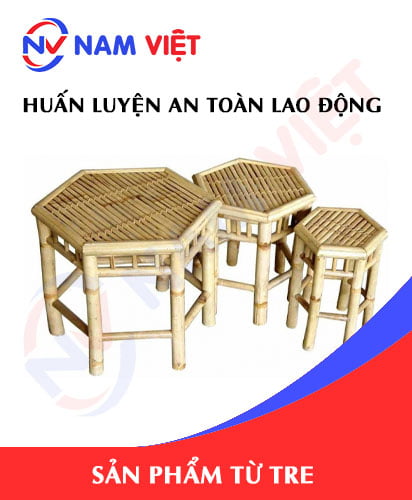Occupational Safety Training in Bamboo Product Manufacturing Factory
99,000 ₫
Note: The above price is calculated for one person, the price may fluctuate depending on the number of trainees participating in the course and the movement of the market. For more accurate pricing support, please refer to the quotation table or contact our consulting staff directly.
Occupational safety is an important issue in bamboo product manufacturing factories and needs to be addressed promptly to ensure the health and safety of workers and enhance the reputation of enterprises. The Occupational Safety Training course is one of the effective solutions to raise awareness about preventing occupational accidents for workers when participating in bamboo product manufacturing.
Table of Contents
Toggle1. Overview of bamboo products
a. What are bamboo products?
Bamboo products are products made from the bamboo plant, a type of plant commonly grown in tropical and temperate regions. Bamboo products are very diverse and popular worldwide, from household products to industrial and construction products. Some common bamboo products include:
- Household items: Bamboo chopsticks, bowls, cups, plates, bookshelves, chairs, tables, mats, curtains, storage baskets.
- Toys: Bicycles, helmets, skateboards, balls, puzzle toys.
- Construction products: House frames, roofs, floors, wall panels, fences, windows, doors.
- Industry: Bamboo paper, bamboo plywood, bamboo particleboard, shipbuilding, footwear manufacturing, handbags, suitcases.
Bamboo products have many advantages such as durability, lightness, easy recyclability, and high aesthetic appeal.
The bamboo product manufacturing industry in Viet Nam is a traditional craft with a long history and has developed strongly in recent years. Bamboo is the main raw material for manufacturing bamboo products, and Viet Nam has many types of bamboo suitable for producing various products.
According to statistics from the General Statistics Office of Viet Nam, the output of bamboo products in Viet Nam in 2020 reached about 5.5 million tons, an increase of 5.5% compared to the previous year. The main products manufactured from bamboo in Viet Nam include bamboo chopsticks, bamboo baskets, bamboo mats, bamboo chairs, bamboo tables, bamboo wall panels, and bamboo home decor products.
The bamboo product manufacturing industry in Viet Nam is facing many challenges, especially in improving product quality, promoting research and innovation, and boosting product exports. However, with the potential and advantages of raw material sources, cheap labor, and some supporting policies from the Government, the bamboo product manufacturing industry in Viet Nam still has many opportunities to develop and compete in the international market.

b. Types of machinery for bamboo product manufacturing
The types of machinery for bamboo product manufacturing are often divided into the following main groups:
- Raw processing machinery: these are machines used for cutting, sawing, splitting bamboo leaves, and sawing bamboo into bamboo slices, bamboo boards, or bamboo fibers for further processing. The machines in this group include: saws, bamboo sawing machines, bamboo grinders, bamboo leaf splitting machines, etc.
- Machinery for manufacturing bamboo products: these are machines used to produce bamboo products after the bamboo has been raw processed, such as: bamboo chopstick making machines, bamboo basket making machines, bamboo table making machines, bamboo wall panel pressing machines, bamboo mat making machines, etc.
- Auxiliary machinery: these are types of machines used to perform additional processing steps and finishing for bamboo products. The machines in this group include: grinders, polishers, printers, engravers, etc.
The types of machinery for bamboo product manufacturing can be adjusted to produce different products depending on the specific product type. However, because bamboo products often have complex shapes and sizes, the manufacturing process often requires special techniques and technology to ensure product quality.

c. Enterprises Manufacturing Bamboo Products in Vietnam
In Vietnam, there are many enterprises manufacturing bamboo products at various scales. Below are some well-known bamboo product manufacturers in Vietnam:
-
- Phu Hai Wood Manufacturing and Import-Export Company Limited: the largest bamboo chopstick manufacturer in Vietnam, headquartered in Binh Duong province.
- Hung Thinh Handicraft Trading and Manufacturing Company Limited: specializes in producing bamboo products such as chairs, tables, cabinets, bamboo mattresses, etc. This company is headquartered in Ninh Binh province.
- Gia Minh Manufacturing and Trading Company Limited: specializes in producing bamboo products such as baskets, containers, boxes, bamboo furniture, etc. This company is headquartered in Ha Noi.
- Kim Quy Manufacturing and Trading Company Limited: specializes in producing bamboo products such as tables, chairs, beds, cabinets, bamboo panels, etc. This company is headquartered in Binh Duong province.
- Truong Phat Manufacturing and Trading Company Limited: specializes in producing bamboo products such as bamboo chopsticks, bamboo baskets, bamboo mattresses, etc. This company is headquartered in Ha Noi.
Additionally, there are many other bamboo product manufacturers in Vietnam, such as Thang Long Furniture Company Limited, Ha Thanh Handicraft Manufacturing and Trading Company Limited, Bac Kan Agriculture Investment and Development Joint Stock Company, Tung Huy Wood Manufacturing and Trading Company Limited, etc.
d. Specific jobs in a bamboo product manufacturing factory
Group 1
- Executive director, deputy executive director, department head in a bamboo product manufacturing factory.
Group 2
- Safety officer: manages safety in the factory, designs safety procedures, monitors and urges employees to comply with safe work procedures.
Group 3
- Sourcing bamboo raw materials: this is the most important job, ensuring quality raw materials for manufacturing bamboo products. This job is often done by purchasing bamboo from bamboo growing areas, farms, or suppliers.
- Raw processing: after sourcing the bamboo raw materials, workers will proceed to cut, saw, split bamboo leaves, and saw bamboo into bamboo slices, bamboo boards, or bamboo fibers for further processing.
- Bamboo product processing: bamboo products can be manufactured in many different ways depending on the product type. Jobs in the bamboo product manufacturing process include: shaping the product, joining the bamboo pieces together, grinding, polishing, painting, carving patterns, etc.
- Product quality control: this is the final job in the manufacturing process, ensuring the product meets quality and customer requirements. This job includes checking the size, shape, color, and durability of the product.
Group 4
- Jobs in the office, service, sales, marketing.
- Production management, quality management, human resource management, material management, financial accounting management.
- Research and development of new products, designing product packaging models.

2. Overview of the labor safety training course for bamboo product manufacturing
Within the scope of this article, we focus on issues related to Group 3, because Group 3 is the group that directly participates in the manufacturing process, bearing the highest risk of labor safety. Refer to other groups here
a. What is Group 3 labor safety training?
- Labor safety training for Group 3 is a series of lessons that equip employees with awareness of how to prevent labor accidents.
- The labor safety training course will help employees recognize and prevent dangers, and limit the risks of labor accidents during work.
REGISTER FOR LABOR SAFETY TRAINING SERVICE
b. Training duration
Initial safety training duration
- The total training duration is at least 24 hours, including the examination time.
- 8 hours of theoretical study on the system of policies and laws on labor safety and hygiene
- 8 hours of theoretical study on basic knowledge of labor safety and hygiene
- 4 hours of theoretical study on specialized training content
- 2 hours of practical training on specialized training content
- 2 hours of theoretical examination at the end of the training course
The safety training center will allocate the time into many training sessions depending on the arrangement of study time for employees. But usually, there will be 6 training sessions, the course will take place in 3 days, on the condition that the manufacturing business can arrange continuous study time.
Periodic safety training duration
- Before the labor safety card expires, if employees want to be re-issued, they must go through a periodic labor safety training course, with the periodic safety training duration being at least 50% of the initial safety training duration.
Explanation: the total periodic labor safety training duration is at least 12 hours, including the examination time. After completing the periodic training course and passing the required exam, employees will be re-issued or have their labor safety card extended.
c. Content of the training course
| STT | TRAINING CONTENT | TRAINING DURATION (HOURS) | |||
| Total | Of which | ||||
| Theory | Practice | Examination | |||
| I | System of policies and laws on labor safety and hygiene | 8 | 8 | 0 | 0 |
| 1 | Overview of the system of legal normative documents on labor safety and hygiene. | 6 | 6 | ||
| 2 | System of technical standards and regulations on labor safety and hygiene. | 1 | 1 | ||
| 3 | Specific regulations of state management agencies on labor safety and hygiene when newly building, expanding, or renovating works, facilities for manufacturing, using, preserving, storing, and inspecting machinery, equipment, materials, and substances with strict requirements on labor safety and hygiene. | 1 | 1 | ||
| II | Basic knowledge of labor safety and hygiene | 8 | 8 | 0 | 0 |
| 1 | Basic knowledge of dangerous and harmful factors at the workplace. | 4 | 4 | ||
| 2 | Methods to improve working conditions. | 1 | 1 | ||
| 3 | Safety culture in manufacturing and business. | 1 | 1 | ||
| 4 | Rights and obligations of employers, employees; policies and regimes on labor safety and hygiene for employees; functions and duties of the labor safety and hygiene network. | 1 | 1 | ||
| 5 | Labor safety and hygiene regulations, safety and hygiene signs, and the use of safety equipment, personal protective equipment; professional skills, first aid for labor accidents, and prevention of occupational diseases. | 1 | 1 | ||
| III | Specialized training content | 6 | 4 | 2 | 0 |
| General knowledge about machinery, equipment, and substances that generate dangerous and harmful factors; analyzing, evaluating, and managing risks related to labor safety and hygiene, safe working procedures with machinery, equipment, and substances that have strict requirements on labor safety and hygiene. | 6 | 4 | 2 | ||
| IV | Safety training examination at the end of the training course | 2 | 2 | 0 | 0 |
| Total | 24 | 22 | 2 | ||
See more training content for 6 groups
d. Labor safety card
After completing the labor safety training course and passing the exam, the employee will be issued a labor safety card (in practice often called a Group 3 labor safety certificate ).
In which, the Group 3 safety card will clearly show information such as: full name, date of birth, specific job and working environment. At the same time, it also has the training duration, a red seal, and a signature confirming the completion of the training course.
According to the regulations on issuing safety cards specified in Clause 2 of Article 24 of Decree 44/2016/ND-CP, it is divided into 2 cases:
- In the case where the employer and the employee have a labor contract with each other, the employer must sign, stamp, and seal the safety card for the trained person in Group 3 after completing the training course from a labor safety training unit, and at the same time passing the exam.
- In the case of a freelance or seasonal worker who does not have a labor contract, the training unit must sign, stamp, and seal the safety card for the employee after completing the training course from a labor safety training unit, and at the same time passing the exam.

3. Identifying hazards affecting employees in bamboo product manufacturing
The hazards related to bamboo product manufacturing can affect the health of employees. Below are some common hazards in the bamboo product manufacturing process and how to identify them:
- During the bamboo product processing, employees can have hand injuries, foot injuries, stabs, cuts, eye injuries, etc. Therefore, production employees must be trained in labor safety and use personal protective equipment such as helmets, safety glasses, gloves, protective footwear, etc.
- During the bamboo product manufacturing, employees can be exposed to toxic chemicals such as glue, dyes, etc. Chemical poisoning can cause symptoms such as headaches, nausea, fatigue, dizziness, etc. Employees need to be trained and use the right protective equipment to avoid chemical poisoning or exposure.
- Employees in bamboo product manufacturing factories often have to operate with heavy equipment, leading to pressure on the spine. When performing repetitive operations, employees can have back pain or herniated discs. Therefore, it is necessary to train employees on how to use lifting equipment and wear helmets when working at heights.
- During the manufacturing process, bamboo shards can create dust and vapors that irritate the respiratory tract. Production employees need to use respiratory protection masks to avoid respiratory tract damage.
- If the electrical equipment in the factory is not regularly maintained, not properly insulated, or waterproof, it will cause the risk of electric shock to employees during the manufacturing process.
4. Common types of labor accidents for employees in bamboo product manufacturing
Common types of labor accidents that occur when manufacturing bamboo products can include:
- Cutting and injury accidents: When cutting, drilling, or handling bamboo, employees can get stabbed, cut, or injured their hands, feet, or other parts of the body.
- Fire and explosion accidents: Bamboo product manufacturing factories often use electrical equipment, welding lamps, electric welding, etc. Employees can suffer burns and explosions when using this equipment.
- Fall, slip, and trip accidents: Production employees in bamboo product factories often have to work at heights, on handheld equipment. During work, employees can fall, slip, or trip from this equipment to the ground.
- Accidents due to improper operation of motors: Machinery in bamboo product manufacturing factories such as saws, drills, etc. can cause accidents if they are not operated correctly or not maintained periodically.
- Accidents involving nails and corrosive liquids: During the manufacturing process, employees can get stabbed by nails or exposed to corrosive liquids if they do not use the right protective equipment or do not comply with safety rules.

5. Safety measures when participating in bamboo product manufacturing
Safety measures when participating in bamboo product manufacturing can include:
- Labor safety training: All people participating in bamboo product manufacturing need to be trained on potential dangers, preventive measures, how to use personal protective equipment, and other labor safety rules.
- Use of personal protective equipment: Production employees need to use full personal protective equipment such as helmets, safety glasses, gloves, protective footwear, masks, and other safety equipment to protect themselves from injuries.
- Periodic equipment inspection: Equipment in a bamboo product manufacturing factory needs to be inspected periodically to ensure that they are still functioning well and correctly. Damaged equipment needs to be repaired or replaced immediately.
- Use of safety equipment: Bamboo product manufacturing factories need to use safety equipment such as fire and explosion warning systems, ventilation systems, and lightning protection systems to ensure safety during the manufacturing process.
- Compliance with safety procedures: Production employees need to comply with safety procedures, including procedures for using equipment, procedures for performing tasks, procedures for safety checks before starting machinery, and procedures for reporting labor accidents.
- Organize fire fighting and prevention training: Bamboo product manufacturing factories need to have a fire prevention and fighting plan and organize fire fighting training so that employees know how to prevent fires and handle emergency cases.
- Periodically organize labor environment monitoring in factories and enterprises, collect and analyze harmful factors to employees, thereby adjusting to reduce the level of harm to prevent occupational diseases for them.
6. Benefits of labor safety training for bamboo product manufacturing
An Toan Nam Viet provides businesses with great benefits after completing labor safety training courses as regulated in Decree 44/2016/ND – CP on labor safety and hygiene work for companies, enterprises, and businesses.
- Employees can identify potential risks of labor accidents and thereby have preventive measures to avoid labor accidents.
- Your business can establish risk prevention measures in the manufacturing, operation, and maintenance process.
- Minimize costs when there is a risk of labor unsafety.
- Uninterrupted manufacturing will help increase labor productivity and product quality.
- Comply with labor safety law regulations, avoiding legal risks.
- Create prestige and professionalism in all aspects, thereby elevating the brand for your business.
Nam Viet’s training courses are a solution to prevent and combat external factors that affect each individual so that they can avoid dangers that can lead to injury or, more seriously, death.
REGISTER FOR LABOR SAFETY TRAINING SERVICE
7. Customer feedback after completing the labor safety training course for bamboo product manufacturing
An Toan Nam Viet has many years of experience in the mission of accompanying many businesses in Viet Nam in general and in the southern provinces in particular. And that responsibility to Nam Viet is something extremely valuable, which is why Nam Viet’s Labor Safety Training work is always focused on becoming more and more professional. And the motivation for An Toan Nam Viet to grow strongly to this day comes from the positive feedback and suggestions from businesses. Below are the feedbacks from our partners that we have served.
Bac Nam E&C Investment and Construction Joint Stock Company
“The first time I used the service at An Toan Nam Viet, I was very surprised by the enthusiastic 24/7 support of the consulting team. The class organization was very quick and convenient for our company, thank you very much for Nam Viet’s service!”
Hoa Dat Construction and Trading Joint Stock Company
“Nam Viet’s service has helped us a lot in simplifying occupational safety and completing safety records for the work process. The consulting team is enthusiastic and timely with our questions. 5 stars for Nam Viet”
See more customer interviews after using An Toan Nam Viet’s service
8. An Toan Nam Viet’s Labor Safety Training capacity
An Toan Nam Viet is a reputable and quality labor safety training center in Viet Nam today. With labor safety training sessions taking place continuously at manufacturing workshops, factories or construction sites across the country (63 provinces and cities in Viet Nam).
REGISTER FOR LABOR SAFETY TRAINING SERVICE
License for labor safety training
- An Toan Nam Viet has been inspected and certified by the Department of Labor Safety of the Ministry of Labor – Invalids and Social Affairs as being qualified to operate in labor safety and hygiene training. This further strengthens our capacity to provide labor safety training.

Documents and lectures
- Before the labor safety training documents are put into the labor safety training courses, they have been reviewed and approved to ensure that the lectures are always correct in terms of knowledge and effective when applied.
- The teaching method of the lecturers is synchronized according to the teaching standards of An Toan Nam Viet, which is a method that experts in labor safety and hygiene training have researched and drawn from the teaching process to bring the highest knowledge acquisition efficiency for students.
Facilities
- Controlling factors in the classroom that affect the training process will increase the teaching performance and the knowledge acquisition efficiency of students.
- Our facilities that support the training course always have spacious classrooms that meet standards for area, lighting, training equipment, etc.
9. Reputable and quality national safety training center
At An Toan Nam Viet, we always put the professional dedication to labor safety training as a top priority. For us, imparting knowledge on how to protect oneself to workers so that they can have a safe foundation on their livelihood path is a contribution to building the country.
To ensure effective training, we prepare carefully and meticulously every little thing, no matter how small. From preparing tools, utensils, teaching equipment to textbooks, documents, sound, and lighting.
Our labor safety training lecturers are experts with many years of experience in the field. They even have research projects identifying dangers in all occupations and how to prevent them.
The lecturer’s lecture is drawn from reality and conveyed in the most vivid and easy-to-visualize way to workers. These factors help workers feel comfortable during their study time and absorb our teaching knowledge well. Of course, the knowledge conveyed always sticks to Decree 44/2016/ND-CP.
From there, they grasp many measures to prevent dangers and how to protect themselves. At the same time, they also apply it in the most appropriate way in their actual work.
Our safety training center is proud to be a reputable and professional provider of labor safety training services with the following advantages:
- Competitive training costs but training quality is still guaranteed.
- Flexible training schedule with the manufacturing situation of the company.
- The procedure for issuing labor safety training certificates is fast and in accordance with the law.
- The training lecturers are people with many years of experience in the profession.
- The classroom is controlled for factors that affect the training process, increasing teaching performance and the knowledge acquisition efficiency of students.
- The lectures are compiled to be suitable for labor safety work in businesses.
- An Toan Nam Viet works with dedication and professionalism to support customers accurately and as quickly as possible.

10. Additional References for Occupational Safety Training in Bamboo Product Manufacturing
- Occupational Safety Materials for Bamboo Product Manufacturing
- Occupational Safety Training Materials Set
- Occupational Safety Training Test Set
- Bamboo Product Manufacturing Occupational Safety Multiple-Choice Test
- Slides for Occupational Safety Training in Bamboo Product Manufacturing
1 review for Occupational Safety Training in Bamboo Product Manufacturing Factory
No comments yet















namchinh.haiphong341
Dịch vụ huấn luyện an toàn lao động rất tốt nhé, giảng viên dạy rất sinh động dễ hiểu!